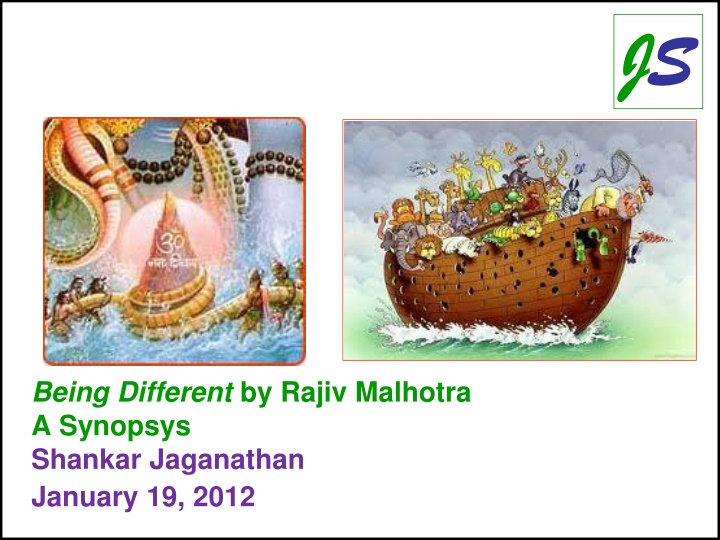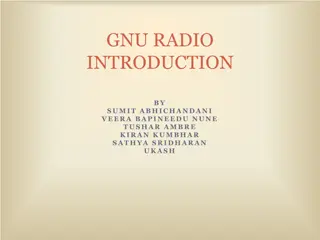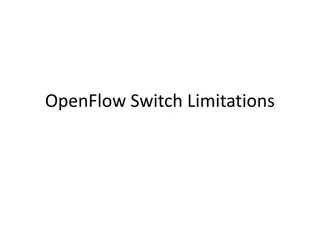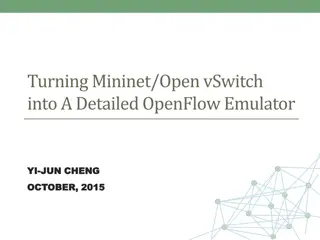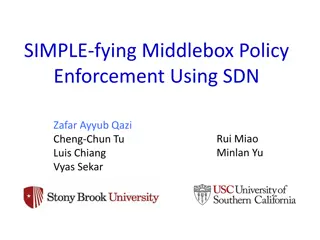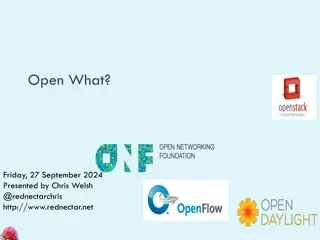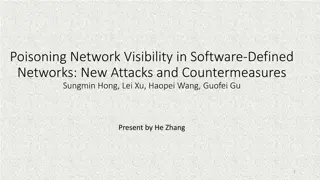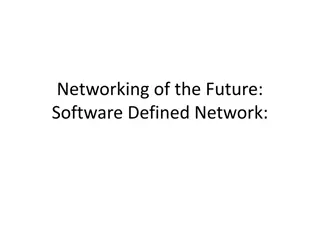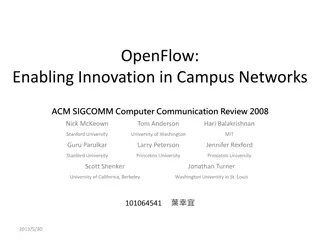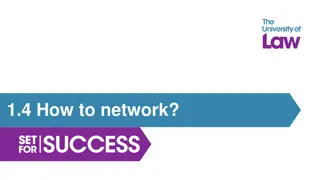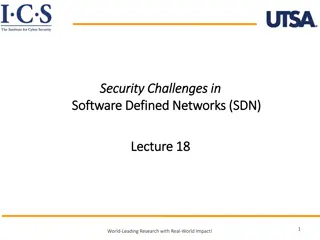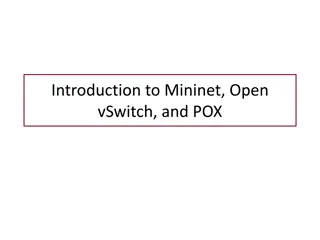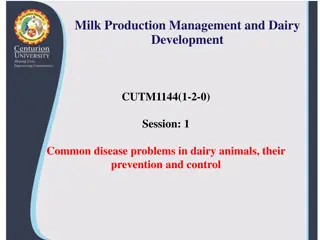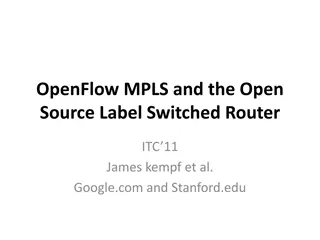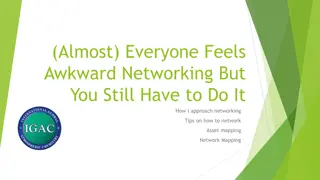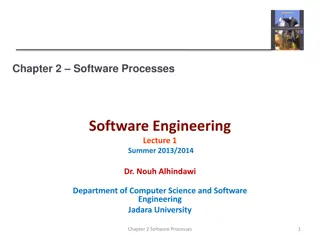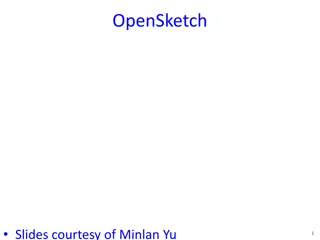Overview of Software Defined Networking and OpenFlow
Software-defined networking (SDN) is an innovative approach that enables network administrators to manage network services through abstraction of lower-level functionality. This includes concepts like control plane, data plane separation, OpenFlow, forwarding abstraction, and state distribution. SDN provides programmable network control, agility in traffic flow adjustments, centralized network intelligence, and open standards-based vendor-neutral configurations.
Download Presentation

Please find below an Image/Link to download the presentation.
The content on the website is provided AS IS for your information and personal use only. It may not be sold, licensed, or shared on other websites without obtaining consent from the author.If you encounter any issues during the download, it is possible that the publisher has removed the file from their server.
You are allowed to download the files provided on this website for personal or commercial use, subject to the condition that they are used lawfully. All files are the property of their respective owners.
The content on the website is provided AS IS for your information and personal use only. It may not be sold, licensed, or shared on other websites without obtaining consent from the author.
E N D
Presentation Transcript
J JS S Being Different by Rajiv Malhotra A Synopsys Shankar Jaganathan January 19, 2012
J JS S Content of the Presentation The Approach Being Different? What is Different 1. Embodied Knowing vs. History Centrism 2. Integral Unity vs. Synthetic Unity 3. Anxiety over Chaos vs. Comfort with Complexity 4. Cultural Digestion vs. Sanskrit non-transferables Western Universalism 2
J JS S Approach Caveats: 1. This is my view of the book, not the book summary 2. Based on my reading of the book, no prior subject expertise 3. I have no knowledge of Sanskrit; a major handicap Objective of the Book (based on what is stated in the book) 1. Set terms for a deeper and more informed engagement between dharmic and western world 2. To highlight the unique and core ideals of dharma using the west as a foil 3. Refute Western claims of universalism Author s Methodology: Purva Paksha Please feel Free to Contribute As We Go 3
J JS S Purva Paksha Effective prerequisites for Purva Paksha 1. Level playing field, terms of debate mutually agreed 2. Intention to pursue truth, not conversion 3. Pursue truth irrespective of ego impact, no compromises to get win-win; 4. Basic self-control /mastery a prerequisite for the practioner 5. Be well informed in both the schools Best example: Mahatma Gandhi and his fight against Colonial rule Use Western Categories Colonial Indology and humanities in today s South Asian Studies Postcolonial Indian scholar who attack the West using western categories Use Dharmic Categories Pre-colonial Indian intellectuals Gaze at Indian Civilization Very rare but the Authors goal Gaze at Western Civilization 4
J JS S My Framework for Understanding Being Different Materialism Abrahamic Religions Judaism, Christianity, Islam Science Spiritualism Tantric practices Mysticism Yoga /Vipasana Rationalism Diagonal Challenge Yoga /Vipasana vs. Abrahamic Religions seen as Embodied Knowing vs. History Centrism Vertical Challenge Integrating Rationalism and Mystism seen as Synthetic Unity reflected in Evolution-Creation debate in the west, and Integral Unity reflected in the idea of Evolution-Involution, leading to acceptance Horizontal Challenge Anxiety over Chaos Science supreme, but inability to explain spirituality Comfort with complexity Sensing adequate, explanations not adequate Cultural digestion vs. Sanskrit non-translatable a challenge of translating multi-dimensional concepts in binary language 5
J JS S Being Different: Visible In Tolerance vs. Respect Western Eastern Charcoal Burner Tribal focus Only path Salvation Evangelizing or Soul harvesting Distrust for other religion, current position tolerate other religions Garland Weaver Individual focus Multiple paths Sat-chit-ananda Individual moksha Mutual Respect for other paths/ religions Late 1990s Claremont Graduate University: Tolerance vs. Respect United Nations Millennium Religion Summit 2000 Replace tolerance with mutual respect Retraced by the Catholic church a month later 6
J JS S Embodied Knowing vs. History Centrism: The idea Top Down-God Initiated Common Ideas: 1. Sole Scripture 2. Original Sin 3. Cannot attain salvation w/o god 4. Externally dammed unless saved 5. Divine grace Push marketing God Incarnate in Person Via Prophets Humanity Bottoms Up-Human Initiated 1. System integrator vs. Pre- configured systems 2. Itihasa vs. History 3. Role of myths and multiple narratives Pull marketing Yoga, Self-less Service, Devotion Human Self-realization Journey 7
J JS S Embodied Knowing vs. History Centrism: Issue of Contention Three Concepts of Secularism 1. Western Secularism: The origin Separation of Church and Government or spiritual and material Separating reason from belief; a palliative remedy, defers the problems Concept does not extend to political spheres: American Presidents God Bless America and current Mormon debate 2. Indian Pseudo-secularism: borrowed from America Constitutional amendment highlighted this concept Dharma-nirapeksha or indifferent to dharma vs. pantha- nirpeksha or indifferent to organized religion 3. All Religions are the same, hence leave it to the individual Opts for a passive role for religion, but problematic due to Claims of only truth by Abrahamic religion 8
J JS S Embodied Knowing vs. History Centrism: Implications Conversion and Excommunication Basis for Conversion World divided into Believers and Heathers Believers are the chosen people Nature available only to the believers for their enjoyment Mandate for the believers to convert heathers: Soul harvesting Basis for Ex-communication Only approach to salvation is through the chosen path No direct communication with the Almighty Claimants for direct contact termed heretic, e.g. Joan of Arc Central authority resulting in Bull: Fatwas of the Church: Birth control, evolution, gay rights 9
J JS S Integral Unity vs. Synthetic Unity: The Idea Integral Unity of the Dharmic world: Involution and Evolution cycle Concept of infinity: Purna Synthetic Unity: Creation and Evolution irreconcilable Dharma Judeo-Christian Belief based Male, Father God and world distinct Individual: sinner One life Circumstances unexplained Salvation: Grace of god Finite time and space, linear Judgment day for humanity Belief independent Impersonal, multiple forms God not separate from world Individual: sat-chit-anand Reincarnation Self-made destiny-karma Moksha: individual effort Infinite cycle of creation No collective end; moksha personal The Ultimate reality The Human The World 10
J JS S Integral Unity vs. Synthetic Unity: Issue of Contention Synthetic Unity: Binary world of True and False Emphasis on reasoning to bifurcate promotes ego or isolation Higher isolation/ inflated ego leads to higher needs Inflated ego promotes selfishness and violence Result, pursuit of infinite growth in a finite world Focus on freedom to A range of states: (7 in number) Negation, Approximation, Absence, Difference (with some similarities), Reduction / Diminution, Badness / unworthy, Opposite/ contradictory Concept of prana unifying mind and body focused on feeling Process to integrate self with the ultimate reality, by eliminating ego Focus on freedom from 11
J JS S Integral Unity vs. Synthetic Unity: Implications Description Dharmic Judeo-Christianity Human centered system Finite Subordinate to man Cosmic centered system Infinite Interdependence World view Time horizon Relationship with nature Approach to problem Concept of Progress Discover solutions Sustainable co-existence Invent solutions Material progress Binary mode of view vs. multiple hues of dharma is seen as dharma being unethical Means vs. end debate and Krishna in Mahabharata A view that ethics as a guide applies only in self-centered actions 12
J JS S Anxiety Over Chaos vs. Comfort with Complexity: The idea Defined, permanent bifurcation vs. Subjective, temporary, classification Biblical view: Good and Evil inherited, Noah and three sons: Ham, Shem, Japheth Dark-skinned Ham & ancestors punished for violating honor Dharmic View: Good and evil, vision based Kashyapa =Vision, Diti= limited/ divided, limited, Aditi= limitless Source of Difference: Desert origin vs. Forest born View Time Karma/ Phala Eternal Temporary History dependent Yes No Psychological implications Tension/ Guilt Ease Christianity Hinduism/ Buddhism Finite Infinite 13
J JS S Anxiety Over Chaos vs. Comfort with Complexity: Issue of Contention Uni-dimensional Ethics: Commandments or the one Right path for all Push for Uniformity Contextualized Dharma: Universal dharma an oxymoron Dharma is life-stage specific, occupation specific and era- specific, Dharma is open ended and evolves Practice can be both right and wrong; they are context specific Push for unity 14
J JS S Anxiety Over Chaos vs. Comfort with Complexity: Implication Satyam-Shivam-Sundaram implications Western view: True, good and beautiful is integrated White skinned, symmetric gods and heroes, dark skinned, malformed villains Was used to justify slavery Dharma View: Beautiful need not be good, good need not be beautiful, both good and beautiful need not be permanent, i.e. true Dark skin seen as beautiful and good, : Rama, Krishna, Vishnu 15
J JS S Cultural Digestion vs. Sanskrit Non- translatebles: The Idea Four levels of Vak (the root/ source of creation): un-manifest, subtle potential, mental image and outer expression Words have multiple meaning and is context specific Bridaranyaka Upanishad: The 3 meanings of Da Translating Sanskrit into other western languages misses the essence It is like assigning constant value to an algebraic variable Brahman and Ishwara God, Impersonal vs. Personal, universe vs. creator Shiva Destroyer, Shiva is transformer, there is no end Atma Soul; True self vs. waiting to be save by God 16
J JS S Cultural Digestion vs. Sanskrit Non- translatebles: Implication Religion viewed Differently Aspects Divine Christian view Distinct from individual Within; but not essential as in Buddhism, Jainism, Carvaka Single source Multiple sources; library vs. books Institution of Church Not essential A standard set: repentance and acceptance Formally granted No formal membership, a way of life Dharmic View Source of Knowledge Governance Route to salvation Multiple routes: Jnana, Bhakti, Karma, Membership 17
J JS S Western Universalization Idea Issues of Contention Binary categories like sacred/ secular, monotheism/polytheism, creation/evolution, political right/left cannot explain Dharma with multiple hues Implications Other cultures selectively used to forward Westernization: Germany and Sanskrit Uni-dimensional concept of success Cultural genocide in the name of development Eliminating local production and seasonal eating Globalization means westernization Progress is salvation or scientific secular progress Concept of Universal History, linear in nature 18
J JS S 19
